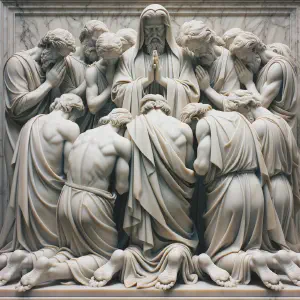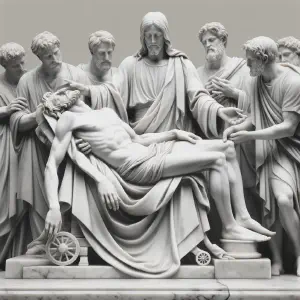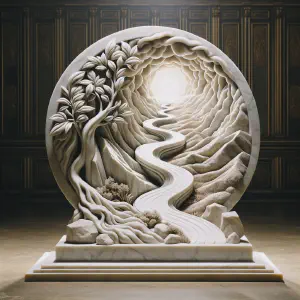Blooming in the Desert
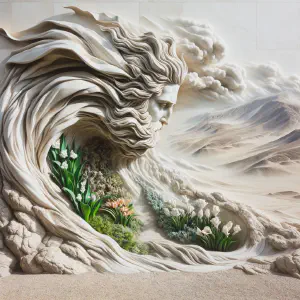

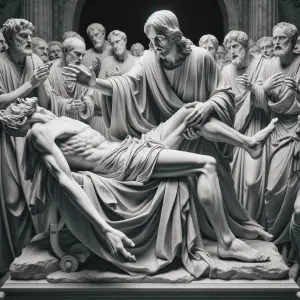
This prophecy found its fulfillment in the presence of Jesus, as he taught amidst a gathering of Pharisees and teachers of the law. Power for healing flowed through him, and his authority was revealed when a paralyzed man was brought before him. Overcoming barriers, the man was lowered from the roof, laying in faith before Jesus. With words that stirred both awe and controversy, Jesus forgave the man’s sins and, demonstrating his divine authority, healed him completely. The man, once bound to his stretcher, rose and walked, a living testament to the incredible works of God, leaving the onlookers in a state of astonished praise.
Five Questions
What is the significance of the desert and parched land blooming in Isaiah 35?
The blooming of the desert in Isaiah represents a profound transformation from barrenness to abundance, symbolizing God’s power to bring life and joy in desolate situations. It’s a metaphor for spiritual rejuvenation and hope, illustrating how God can renew and revitalize even the most lifeless aspects of our existence.
How does the healing of the paralyzed man in Luke’s Gospel connect to the themes in Isaiah?
The healing of the paralyzed man by Jesus embodies the physical manifestation of the spiritual renewal described in Isaiah. Just as the barren lands are transformed into flourishing fields, the paralyzed man’s healing signifies the transformation of a life hindered by physical and spiritual limitations to one of freedom and vitality. It’s a testament to the power of faith and the authority of Jesus to bring about change in our lives.
In Psalm 85, there’s a mention of “kindness and truth meeting, justice and peace kissing.” How does this relate to the overall message?
This verse from Psalm 85 beautifully encapsulates the harmonious nature of God’s kingdom, where divine attributes coexist in perfect balance. It relates to the overall message by emphasizing that God’s plan involves not just physical restoration, like in Isaiah, or individual healing, as seen in Luke, but also a holistic restoration of righteousness and peace in the world. It’s about the coming together of different aspects of God’s grace and justice.
The term “ransomed” is used in Isaiah. Can you explain its significance in the context of these scriptures?
In the context of these scriptures, “ransomed” refers to the act of being liberated from bondage, which is a key theme in biblical salvation. It signifies the redemption and freedom granted by God to His people. In Isaiah, it speaks to the liberation from spiritual exile and despair, while in the New Testament, it’s often associated with the salvation brought through Jesus Christ, freeing us from the bondage of sin and death.
What is the “holy way” mentioned in Isaiah, and how does it connect to the New Testament teachings?
The “holy way” in Isaiah is a metaphorical path that represents purity, safety, and a direct route to communion with God. In the New Testament, this concept is echoed through the teachings of Jesus, who is often referred to as “the way, the truth, and the life.” This path is devoid of spiritual dangers and is accessible to all who seek redemption and a relationship with God, underscoring the accessibility of God’s salvation to all who believe.
Bible Study
Isaiah 35:1-10
The desert and the parched land will exult;
the steppe will rejoice and bloom.
They will bloom with abundant flowers,
and rejoice with joyful song.
The glory of Lebanon will be given to them,
the splendor of Carmel and Sharon;
They will see the glory of the LORD,
the splendor of our God.
Strengthen the hands that are feeble,
make firm the knees that are weak,
Say to those whose hearts are frightened:
Be strong, fear not!
Here is your God,
he comes with vindication;
With divine recompense
he comes to save you.
Then will the eyes of the blind be opened,
the ears of the deaf be cleared;
Then will the lame leap like a stag,
then the tongue of the mute will sing.
Streams will burst forth in the desert,
and rivers in the steppe.
The burning sands will become pools,
and the thirsty ground, springs of water;
The abode where jackals lurk
will be a marsh for the reed and papyrus.
A highway will be there,
called the holy way;
No one unclean may pass over it,
nor fools go astray on it.
No lion will be there,
nor beast of prey go up to be met upon it.
It is for those with a journey to make,
and on it the redeemed will walk.
Those whom the LORD has ransomed will return
and enter Zion singing,
crowned with everlasting joy;
They will meet with joy and gladness,
sorrow and mourning will flee.
This passage depicts a transformation from desolation to abundance, representing hope and divine intervention. The desert’s blooming symbolizes God’s power to rejuvenate and bring joy. It aligns with Catholic values of hope and trust in God’s providence, resonating with the concepts of divine grace and mercy. The imagery of a safe, holy path reflects the Church’s teaching on the journey towards salvation and the kingdom of God.
Psalm 85:9ab and 10, 11-12, 13-14
R. (Isaiah 35:4f) Our God will come to save us!
I will hear what God proclaims;
the LORD –for he proclaims peace to his people.
Near indeed is his salvation to those who fear him,
glory dwelling in our land.
R. Our God will come to save us!
Kindness and truth shall meet;
justice and peace shall kiss.
Truth shall spring out of the earth,
and justice shall look down from heaven.
R. Our God will come to save us!
The LORD himself will give his benefits;
our land shall yield its increase.
Justice shall walk before him,
and salvation, along the way of his steps.
R. Our God will come to save us!
Psalm 85 celebrates God’s peace and righteousness. The meeting of kindness, truth, justice, and peace symbolizes the harmonious nature of God’s kingdom and His promises. This aligns with Catholic teachings on God’s justice and mercy, emphasizing the importance of living in truth and peace as part of Christian life. It reflects the Catholic understanding of divine justice, emphasizing God’s active role in guiding humanity towards righteousness and peace.
Luke 5:17-26
One day as Jesus was teaching,
Pharisees and teachers of the law,
who had come from every village of Galilee and Judea and Jerusalem,
were sitting there,
and the power of the Lord was with him for healing.
And some men brought on a stretcher a man who was paralyzed;
they were trying to bring him in and set him in his presence.
But not finding a way to bring him in because of the crowd,
they went up on the roof
and lowered him on the stretcher through the tiles
into the middle in front of Jesus.
When Jesus saw their faith, he said,
“As for you, your sins are forgiven.”
Then the scribes and Pharisees began to ask themselves,
“Who is this who speaks blasphemies?
Who but God alone can forgive sins?”
Jesus knew their thoughts and said to them in reply,
“What are you thinking in your hearts?
Which is easier, to say, ‘Your sins are forgiven,’
or to say, ‘Rise and walk’?
But that you may know
that the Son of Man has authority on earth to forgive sins”–
he said to the one who was paralyzed,
“I say to you, rise, pick up your stretcher, and go home.”
He stood up immediately before them,
picked up what he had been lying on,
and went home, glorifying God.
Then astonishment seized them all and they glorified God,
and, struck with awe, they said,
“We have seen incredible things today.”
This passage recounts Jesus healing a paralyzed man, showcasing Jesus’ role as a healer and forgiver. It highlights the power of faith and community, as seen in the actions of those who brought the man to Jesus. This miracle aligns with Catholic teachings on the sacraments of healing (Anointing of the Sick) and reconciliation (Confession). It emphasizes the importance of faith, community support, and the role of Jesus as a source of spiritual and physical healing, resonating with Catholic values of compassion and the acts of mercy.
Lessons
These passages illuminate the transformative power of God’s presence in our lives, both spiritually and physically. The imagery of a desert blooming signifies hope and rejuvenation in seemingly lifeless situations, symbolizing God’s ability to bring life and joy where there is barrenness. The healing of the paralyzed man by Jesus in the Gospel of Luke demonstrates the power of faith and the authority of Christ to forgive and heal. These scriptures remind us of the importance of trusting in God’s plan, recognizing His power to transform our lives, and the salvation that comes through faith in Jesus Christ.
Meditation Prayer
